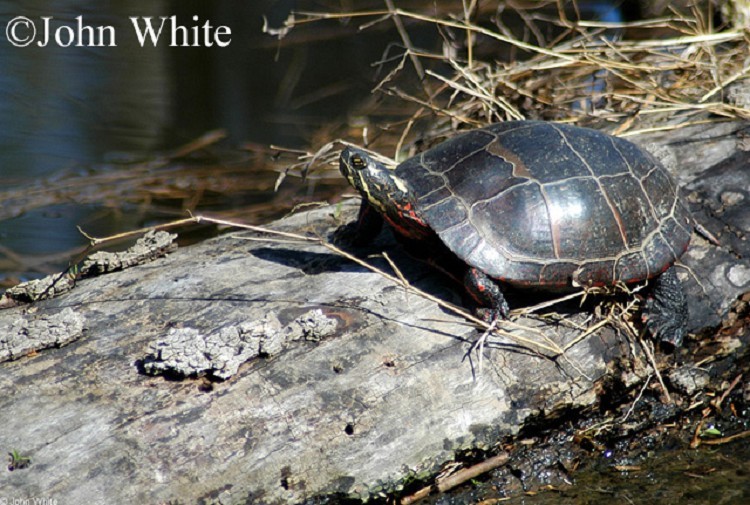Eastern Painted Turtle, Chrysemys picta
Two subspecies are recognized in TN: Eastern Painted Turtle (C. p. picta) and Midland Painted Turtle (C. p. marginata). Eastern Painted occurs in the Blue Ridge Mountains, while Midland Painted occurs in the Tennessee River drainages.
Description: A small, colorful, aquatic turtle (4.0 to 6.0 inches in length) with a smooth olive to black carapace (upper shell), which lacks a keel. Marginal scutes (plates) have prominent red coloration. The sides of the head and chin have yellow striping and a noticeable yellow spot occurs behind each eye. Eastern Painted Turtles have scutes that form straight rows across the back with light bands showing between the plates. Midland's have a dark, oval spot (variable in size and shape) in the center of the plastron (lower shell). Young are more brightly colored and have a slight keel on their back.
Similar Species: Southern Painted Turtle usually has a prominent red or orangish stripe running down the center of the back and a yellow plastron, but genetic analysis is required to positively distinguish from Painted Turtle.
Habitat: Prefers shallow bodies of water with soft, muddy bottoms and plentiful aquatic vegetation; examples include lakes, rivers, ponds, wetlands, ditches, oxbows, and reservoirs.
Diet: Plants and animals including algae, duckweed, snails, crayfish, frogs, and fish.
Breeding information: Courtship and breeding occurs in late winter and spring. Females will dig a nest in open sandy areas, or areas with loose soil, and lay 4-20 elliptical white to cream colored eggs per clutch. Eggs hatch in approximately 6-10 weeks, remaining in the nest through the winter until emerging in the spring.
Status in Tennessee: A fairly common and abundant species across the state. Vulnerable to destruction of habitat and being killed on roadways.
Fun Facts:
- Spends a lot of time basking on logs, rocks, or other objects.
- Painted Turtles may live up to 60 years.
Best places to see in Tennessee: Perched on fallen trees in shallow ponds or lakes covered by duckweed or lily pads.
